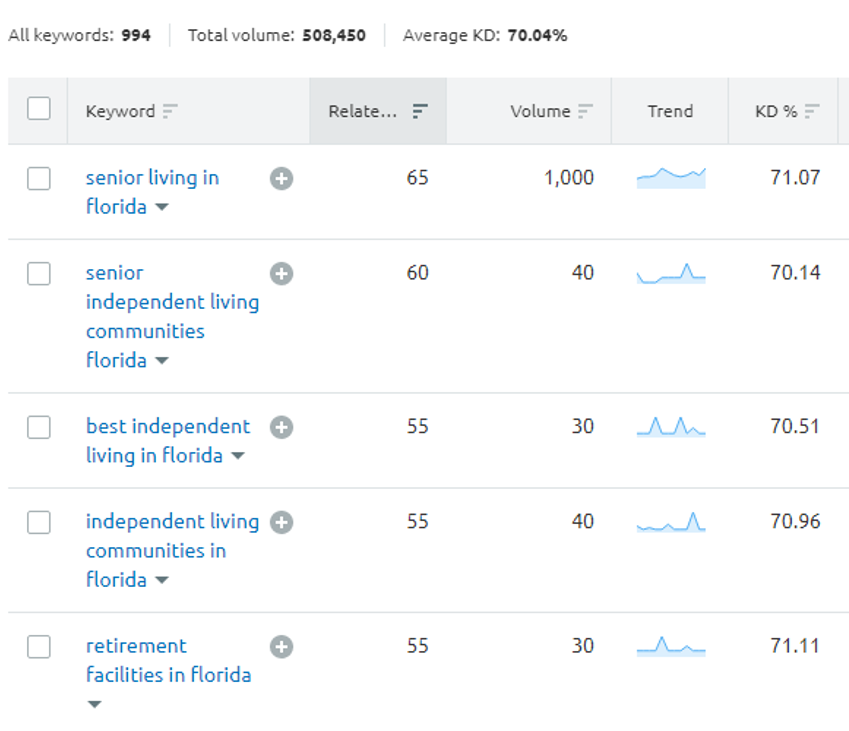Your Senior Living Marketing Plan for 2021
Too often, marketing and sales teams stress out when creating their yearly senior living marketing plan. At the end of December or beginning of January, they will create complex, color-coded spreadsheets with endless tasks and dates and “ownership.” (Often, no one ever looks at the plan again!)
Don’t get us wrong: Planning is important. But it’s impossible to plan a whole years’ worth of marketing tasks in one fell swoop. Instead, it makes more sense to develop an overarching plan for the year—that famous 30,000-foot view. From there, you can create tasks per quarter. (And you don’t need to create the quarterly tasks all at once, either.)
Talk about a much easier approach, right?
The purpose of this post is to help you with that 30,000-foot view.
We recommend getting your team together and talking through the following four main buckets. An important note: You will need to think about them in conjunction with each other. But to start, devote four separate afternoons. Spend each one on a different bucket. On the fifth day, bring it all together and develop your broad-stroke senior living marketing plan to guide you for the year.
What comes out of your discussions will vary depending on your community. It will also depend on the type of year you had, your goals for next year, and your budget. Below, we’re including some questions to get the ball rolling.
CAVEAT: If you’re reading this in 2020, you can’t go into 2021 without thinking about the pandemic. So your 30,000-foot view needs to include the reality of COVID-19. Hopefully, it will be a different story when we enter 2022. If you haven’t already done so, be sure to get instant access to our COVID-19 marketing assets.
1. Senior living marketing plan: Think search.
Let’s face it: Almost everyone begins their searches online. This is certainly true for older adults, which is why the foundation of every senior living marketing plan needs to be search and SEO.
Some questions to ponder or to kick-start your discussion:
- How often did you conduct keyword research last year? Be honest! If you’re reading this in 2020, we wouldn’t be surprised if the answer is “not much” since everyone was dealing with COVID. If that’s the case, make it a priority going into 2021.
- When’s the last time you did a site optimization audit? Your website is a machine. Like any machine, it requires maintenance.
- If you’ve been running paid search campaigns, how have they been working? Review metrics, including the most important one: move-ins. Have your PPC campaigns performed well? Do you want to increase the budget? If they haven’t performed, is it because they’re not the right campaigns? Or is PPC not right for your particular community at this time? Meaning you might want to put the budget towards something else for part of next year and revisit?
No doubt, you’ll come up with plenty of other discussion points around search. Keep track of the big items and themes. For example, maybe you come out of this meeting with something like the following:
- Perform fresh keyword research in Q2.
- Re-optimize site, as needed, in early Q3.
- Increase budget on Facebook ads, decrease budget in Google AdWords.
2. Senior living marketing plan: Think content.
As we like to say around here, content isn’t king—it’s emperor. People crave content at every stage of their journey. Your job is to make sure what they need is available to them when they need it.
At the very least, your content strategy will involve discussions around:
- Blogging. You should enter January with a three-month editorial calendar in place. The calendar should include keyword-rich topics, blog writing assignments, and due dates. In fact, when you enter January, you should already have the completed January content in hand. Your team should be working on February content.
- Premium content. Aim for a good mix of gated pieces that will entice people to provide their email address so you can continue nurturing them.
- Social media. We don’t have to tell you how personal senior living is. Your community should have an active and engaging presence on places like Facebook and Instagram. From a business standpoint, maintain a good LinkedIn page so you can continue to attract great employees. (Make sure you’ve claimed listings on places like Glassdoor and LinkedIn as well.)
- Email marketing associated with automaton. We’ll dig into this more in the automation section below. Bottom line, though: Don’t simply set it and forget it.
Again, the above will get you started, but it isn’t an exhaustive list of items to think about. Always look at content holistically. For example, is there a “theme” you’d like to focus on for the first half of 2021? Maybe it’s around “choosing senior living during uncertain times.” How can different channels—blog, email, social, premium content, and so forth—support that theme?
Try to walk away from this brainstorming session with a couple of larger themes for next year that will drive your month-to-month content creation.
3. Senior living marketing plan: Think automation.
We’ve written A LOT about marketing automation. If there’s one thing ALL senior living communities can do better, it’s in this area.
If you have marketing automation…
- When’s the last time you looked at analytics? Review the last two quarters. What surprised you? What made you excited? What worried you? Bottom line: you’ll want to do more of what’s working. And you’ll want to reassess what isn’t.
- When’s the last time you reviewed the content of your lead nurturing campaigns? Too often, we see communities set up their lead nurturing email campaigns and never look at them again. Some messages will be evergreen. But others will need tweaking. For example, what you said in May of 2020 will (thankfully) sound different from emails sent during May of 2021.
- Consider your leads. Not just the number of overall leads, but conversions to move-ins. What’s the quality of SQLs? What’s the breakdown of MQLs to SQLs in the database? Etc.
If you don’t have marketing automation . . .
- Read why you need marketing automation.
- Create a task force for choosing the right automation software. (Or call us to guide you!)
- Implement it. (Or call us to help!)
While your marketing team will be involved in all of these discussions, you should absolutely include sales in any discussion pertaining to lead gen. They know the leads. They can speak to their quality—or their perceived quality.
4. Senior living marketing plan: Think outsourced marketing agency.
Are you currently working with a marketing agency? If yes, are you happy with the engagement? If not, why not? Can you communicate your concerns with the agency and discuss strategies for moving forward together? Or is it time to make a change? If it’s time to make a change, what will be the process for making a switch? (Who will own it?)
- Hint: What’s the sign of a truly good agency? They’re actively involved in planning next year’s marketing. In fact, they’re likely driving the discussion.
If you’re not working with an outsourced marketing agency, discuss whether it would make sense to do so. What sort of budget do you have? What are your expectations?
- Hint: If you’re going to use an outsourced agency, make sure they have experience in senior living!
And on the fifth day of planning your senior living marketing . . .
Now, you’ll bring it all together: Your themes. Your goals. Your plans around search (organic and paid). Your content strategy. Your marketing automation tasks. Your budget. Make sure everyone is on the same page regarding these things. Then, create your Q1 marketing calendar. Use your tool of choice—Asana, Trello, Google docs, Basecamp.
Think of your senior living marketing plan as the roadmap. Think of the month-to-month calendar as the actual driving directions and milestones (tasks) along the way.








